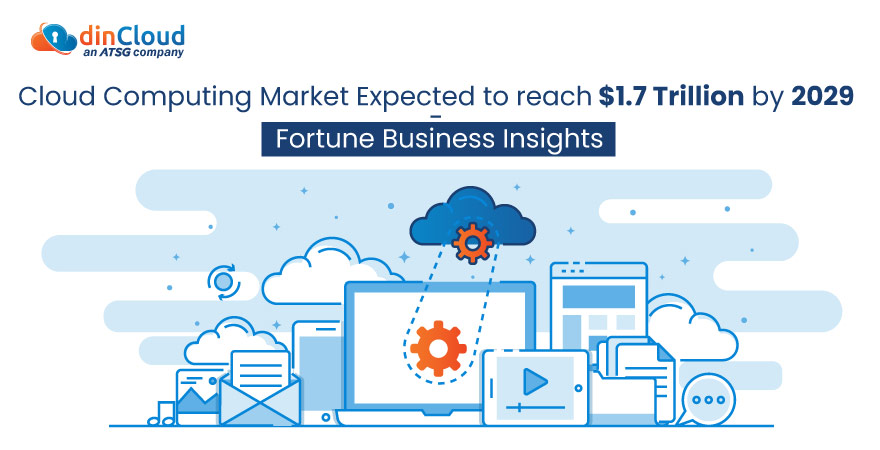With multiple enterprises embarking on a journey to the Cloud, the C-suite tries to grapple with various important questions about Cloud Computing; What is the true financial and non-financial value of the Cloud?
Fortune Business Insights has made a forecast that the global Cloud Computing market is expected to reach USD$ 1,712 billion, by the year 2029. This market is reported to have a Compound Annual Growth Rate (CAGR) of 19.9%. Currently, the Cloud Computing market stands at USD $480 billion.
Fortune Business Insights have made a 140 pages long report called “Cloud Computing Market, 2022-2029.”, and it states very promising stats about the future of Cloud-based services and solutions. The report suggests that factors like surge in internet penetration rates, explosion in digital transformation (Artificial Intelligence (AI), Machine Learning (ML), etc. and exponential increase in smartphones usage, are major contributing factors behind the growth in this industry.

Keeping these positive trends in mind, key industry players are willing to inject funds in next-generation industrial solutions, as well as for the security of data centers, to mitigate the impact of cyber security incidents.
Related: Future Market Insights Featured dinCloud In DaaS Report
Cloud-based Innovations Accelerating Due to Heavy Investments
Even though the global pandemic hit the international economy like a violent storm, the Cloud Computing market was one of the very few market segments during these testing times, which managed to flourish due to high demand of remote based work.
Numerous leading companies have increased investments in Cloud-based infrastructures. An IT based consultancy firm, Accenture Solutions, upped their Cloud adoption and digital transformation investment to UD $3 billion, in the year 2020.
AWS expanded its data center footprint to Italy, with a view to boost research regarding hybrid work environments in 2020.
Artificial Intelligence (AI) and Big Data aiding in Cloud Computing Innovations
For augmentation of data usage and reduction in data storage difficulties, key industry participants are expected to expand investments in Big Data, AI, and ML technologies.
Related: The Global DaaS Market Could Reach US $18 BN by 2029 – FMI Report
The Cloud Computing market is witnessing a preference towards the insightful AI-powered services and solutions. There has also been an increased investment in the Cloud by the healthcare sector.
The overall trends in the Cloud Computing industry are favorable, however, the pervasive nature of cybersecurity risks adversely impacts this thriving market.
The Fortune Business Insights report has dived deep into the qualitative, as well as quantitative analysis of the Cloud Computing market. It taps into both primary and secondary resources to have an insightful and holistic picture of the overall characteristics and condition of this market. The report suggested that out of all the types, services and industries, the following market segments are expected to grow the most over the next few years.
Related: The Global IaaS Market Could Reach US $1.3 Trillion by the Year 2028
Hybrid Cloud Becoming the Most Preferred Model
The present trends suggest that out of Private, Public, Hybrid and Multi Cloud models, Hybrid Cloud is the most preferred type of IT infrastructure and it is expected to grow at a very fast pace.
Software-as-a-Service (SaaS) Dominating the Services Segment
According to the Cloud Computing Market Report (2022-2029), SaaS sits right at the top as the most preferred service, as compared to Infrastructure-as-a-Service (IaaS) and Platform-as-a-Service (PaaS). The reason for this increased popularity of SaaS is easy deployment and reduced costs.
Healthcare Sector Leaving Behind All Other Sectors in Adopting Cloud-based Solutions
The report segregated the overall Cloud market into these sectors: Information Technology and Telecommunication, Healthcare, Manufacturing, Government, Banking, Financial Services and Insurance, Retail and Consumer Goods.
Out of all these sectors, the Healthcare sector is expected to invest the most in Cloud Computing services, particularly in Cloud-powered wearable devices.
Region Wise Market Analysis
The North American market looks very lucrative when it comes to the adoption of technologies such Cloud Computing, Internet of Things (IoT), ML and AI. In 2021, the cloud market size of North America was worth US $ 262 billion. This market is expected to grow manifolds, particularly in the U.S and Canada.
Government and private sectors in the European Cloud Computing market are also expected to see noticeable growth. The advanced economies of the European market will foster innovation in the technological world in general, and Cloud Computing in particular. A German multinational software company, SAP SE, officially launched a sovereign platform for Cloud-based data processing/ in the first half of this year.
Related: GPU Cloud Computing Market Set for Growth b/w 2022 & 2028
The healthcare sector in the Asia Pacific market is expected to aggressively leverage Cloud Computing services. Markets of China and India, predominantly look very promising when it comes to the utilization of Cloud Computing services, especially the extremely sought-after Cloud-based solutions in smart cars.
Conclusion
The importance of Cloud Computing is un-deniable, especially in the post-pandemic world. Since today’s business world is very well aware of the financial value of the Cloud, therefore, the injection of heavy capital in Cloud-based environments is a no-brainer for most businesses.
It is imperative for enterprises to stay relevant, practice sustainability, maintain their competitive edge and be well-prepared for the future. Cloud Computing solutions can help businesses consistently move in the right direction.
Cloud Service Providers (CSP), like dinCloud, offer scalable, secure, agile and customizable Cloud-based services and solutions for your enterprise, at flat rate pricing.


